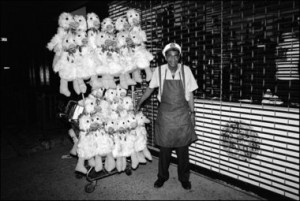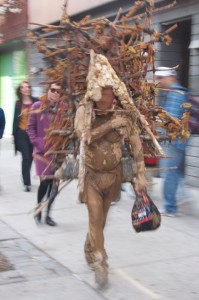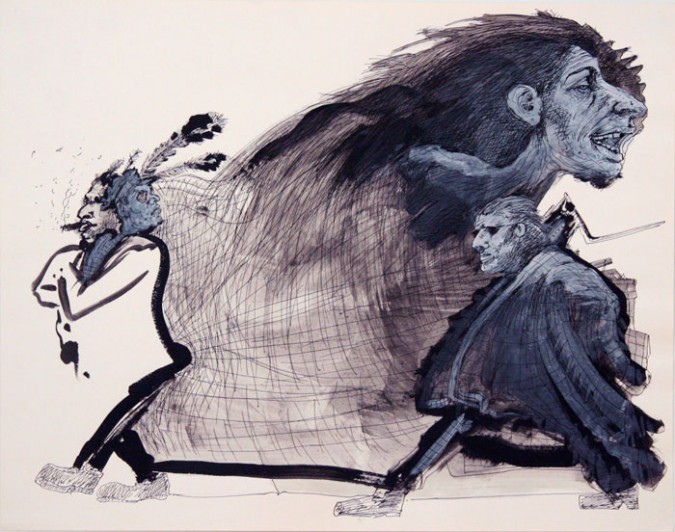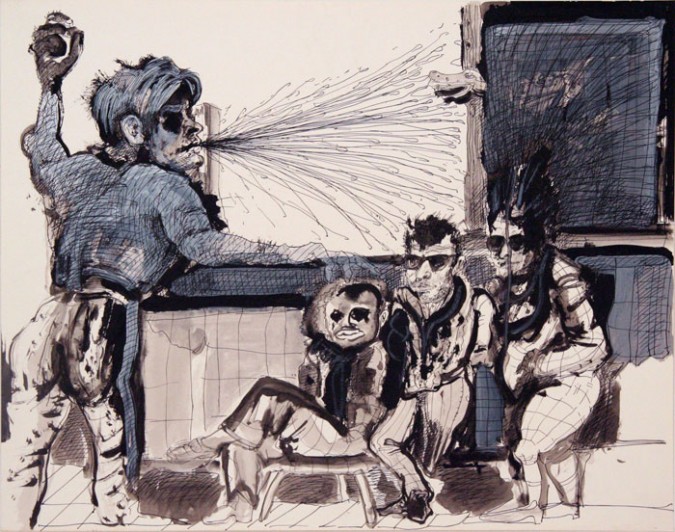Kim Jones at Pierogi
Allow me a moment’s nostalgia. Perhaps it isn’t so strange how accustomed we all became to the Mudman. It was 1980’s New York; New York then as opposed to New York now. There were still transvestite bikers, and the guy doing the ceramics thing all over the East Village. There was the Duckman wandering lower Manhattan by night selling nothing but large yellow stuffed ducks. There was the saxophone player who rode the number 6 train with a litter of kittens climbing through his hair. After a while they all seemed to fit right in. Artist, not-artist it seemed moot. Then, skip a decade, and I remember the Mudman hanging out near an opening at Mary Boone’s. It was 92 or 93, when she was still on the East side of West Broadway. Before she pulled up sticks for midtown. Perhaps by then the whole scene felt a little mannered. By then the ducks and their man had disappeared. One could fear for patrons in SOHO that they would track recently shed flakes of mud and twig into the emporia of the bourgeoisie. But there he was, as I remember it, Mudman, chatting amiably with someone outside Boone’s.
Mudman was born to/by Kim Jones in Los Angeles in 1976 in a performance wherein Jones in combat boots and Mudman costume walked the length of Wilshire Boulevard from dawn until dusk. He invested the streets of that sun blinded city with a beguiling presence until his migration to New York in the 1980’s. His backstory includes a stint in the Marine Corps, followed by a stint in art school, an embrace of performance art at the extreme and a famed come notorious performance where he immolated live rats before a live audience.
His signature piece is of course the years-long amble through 1980’s Manhattan –seeming himself to be part of that ongoing ruin of New York– costumed in his wattle and daub thatch, caked with mud and twigs, arms and shoulders supporting the spiky, jagged, branches-akimbo costume. However, throughout his career Jones has also fashioned works on paper. Ink drawings, graphite on paper –so called ‘war drawings’– or interventions in/on photographs with ink, acrylic or collage. In a great many of these the Mudman makes an appearance interacting with other figures; his own bestiary perhaps. The current Jones’ show at Pierogi, titled Averno, puts forward 20 or so of these flat works.
Enigmatic Averno? The viewer pauses to percolate the word. Averno, it turns out, is a lake, a volcanic crater, lake, in southern Italy. In Classical Antiquity it was known to the Romans as the entrance to Hades: the gateway to hell. It is not hard to covet such magical and poetic geography as that lived upon by the Romans. Jones, for his part takes loan of the magic of Averno to shade his work.
Jones arrived back ‘Stateside’ from his tour as a Marine in Viet Nam in 1968. He enrolled in Cal Arts for a BFA program followed by an MFA at Otis Art Institute completed in 1973. Both daily life and studio practice became the sites of processing –filtering, mediating, repressing, repeating, regurgitating– his experience in the war zone. And, as a member of a fledgling group of southern Californian Body/Performance artists, daily life and studio practice became increasingly entangled. This processing of his war experiences has been a part of his working life as an artist ever since.
The American War in Vietnam emerged as a cultural meme while the war was still being fought. John Wayne and his Green Berrets (1968), were all for it. Allen Ginsburg, in Oakland/Berkley as early as 1965, was very much against it and said so. Yet the war was also there in submerged form in much other cultural work that did not enunciate it with an explicit voice. With Chris Burden, in those early works –Shoot, 1971; Fire Roll, 1973– Vietnam is an undertone. (Twenty years later it will be there as a loud polemic in his response to Maya Lin’s memorial.) What Burden and Jones do share –with us, the viewer– in those early performances is that in the face of rats on fire and artists being actually shot, instrumental reason collapses and the viewer’s soul is forever jangled. In the 1960’s and 70’s as we watched the war unfold in real time on TV reason strained, tortuously so from the lies of Tonkin to the horror of napalm and My Lai, but its reason –to prevent another domino from falling– occluded not the horror itself but the traumatized silence that needs be attends such horror. We argued the politics in place of falling into traumatized mutism. What Jones and Burden, and others, did was foreground traumatic effect beyond rhetorical context. They returned us to the primary node of trauma, silence: an incapacity to represent the horror. I mean, really, what can you say about a guy who just set live rats on fire in front of you?
And, double-time forward to New York’s SOHO in the 1980’s and we find Mudman presenting the Saturday evening boulevardier, trawling for the crepuscular, frisson of Champagne gallery openings at Boone’s and the beginning’s of high end fashion stores on West Broadway, with a boilerplate ‘type’ of otherness. Without Jones’ own history –which provides his conceptual garment of context– his garment of sticks and mud, jarring, arresting though it was, seemed a vague mélange of Borneo filtered through National Geographic. As viewer, cycling through the references for the mud and sticks one was easily outpaced by the commonplace. And always the commonplace shuts you up.
Two different modes of silence then: the first induced by horror. In the second the figure of enigma is hijacked by the already known. In the latter I can find a way out of the silence, a slot opens in the boilerplate to explain the experience. In the former I am just aghast. In the latter I can tinker with reference. In the former I remain hushed, speechless. Thus there is something in this, that this globbed onto stereotype; this received idea of ‘the other’ endures for Jones through time and place. There is something to be understood about an invented ‘character’/caricature of otherness, that lasts from the Wilshire Boulevard Walk of 1976 –just a couple of weeks before he torched the live rats– to the drawings in the current show.
In the drawings throughout Jones’ career, and thus also here in Averno, a timeless space is concocted where an Eros-Thanatos, cocktail parade –bringing to mind Hogarth as much as the New York Dolls– slides into an erotic fumble with itself. The figures in Jones’, Rake’s Progress merge with one another, they defecate, urinate and vomit at and on each another. This body part here touches that part there; this spill of ink becomes an intestinal tract that enfolds this penis over there. The wiggly line that represents someone’s wig becomes someone else’s tongue. The heavy line that defines the rear of one body is shared as the back of another figure’s head. There are many inky tentacles that reach out across the page and make octopus like gestures of embrace, there are endless bodily transactions to be graphically invented. But they all begin in more or less recognizable images: a 1970’s ‘do’ that could double as a Marie Antoinette hairpiece; a Rastafarian dreadlock that translates itself into the Mudman’s costume, a punk-pink hair style that echoes with a funeral pyre. In the past starting points have been tear sheets from Jansen’s History of Art, family photographs and images from ‘girlie’ magazines. Here, in the Averno series, figures stand against backgrounds that resemble field works and trenches from WWI while the Mudman costume becomes a frail tank trap. Jones is lurking in both public history and private memory, scavenging in both places for the right cue to connectedness.
Jones also has a history of meandering through time in his drawings. Signed into the corner of the work, in a fully normative convention will be the date; say 1972. However, 1972 may be followed, on the same drawing, by 1976 and 2011. He returns to the seemingly never finished drawings again and again. The nomadic course of the performer, in true repetitive compulsive style, is inscribed into the static work as much as in the actual amble of the Mudman. Given this dating – and the psychological vagabondism it implies– given the insubstantiality of boundaries and bodies in the drawings, I am not sure you can ever say the Viet Nam war is Jones’ past because his past is forever in his present. It, the war, ricochets around his psyche like there were no time line. Or, with Freud in his version of an unconscious, the memory-history continuum is timeless and fluid. It is absolutely without temporal logic and law.
It is in the nature of traumatic reactions, and not coincidentally in the treatment of trauma’s victims, that there is a return again and again to the same site, the same image, memory or word. In this revisiting and reworking of the same material there is a searching for the right way, the correct form, if you will, to represent trauma. The silence, the muting that trauma induces, the collapse of meaning that it presages has been addressed, perhaps most publicly in recent times, by W.G Sebald in his series of lectures come essays published in The New Yorker in 2002. Sebald justly chides the commonplace of, say melodrama, as a literary form to exchange images of mass killing with others. In the psychoanalytical conversation what unfolds from the naming of the commonplace, (thus marking one difference between literary production and the discursive product of clinical experience) is a naming of the connections and kin of the commonplace. In this manner, by returning again and again to the same site or moment, one constructs its hidden economy and history. Perhaps, in the end, each and every one must develop their own idiosyncratic language of traumatic experience. So, somewhere in reconfiguring the relationship to one another of all these, so to speak, kin, as Jones does in his drawings, one may arrive at not a destination but rather a procedure for conjugating the terms of trauma. One will probably need to re-conjugate the terms many a time; revisit the drawing perhaps in a year or two and then again, well you get the picture.
None of this is to say that the effect of trauma is easily ameliorated. Cut-piece was a 1981 performance Jones describes in his contribution to Unwinding the Viet Nam War. Cut-piece: Jones is naked save for a Mudmanish head piece. He and his audience are “packed tightly into a small space”. He cuts himself twenty seven times with a razor blade. With pencils attached to the headdress and the flowing blood he begins to draw a self-portrait. He lies down and begins to whisper, “get out of my room get out, get out”. “Packed tightly into a small space” seems pretty important. The footlights separating performer from audience evaporate and re-traumatizing the victim traumatizes the viewer. A sort of domino effect you could argue. The same blank space of the unspeakable is ritually passed on. It is a grandly theatrical version of the quotidian theater of, say, a Holocaust survivors remembering by repeating. In this latter genre of traumatic reverberation, for no apparent reason the survivor, lets say the parent, checks the windows every 30 minutes throughout the night. This unconscious mechanism of telling and learning is dubbed the intergenerational transmission of trauma. It gets the experience of trauma across without exactly telling us what happened.
One could say it is relatedness that trauma denies. Trauma isolates; ‘you did not, you cannot share what I experienced’. And of course once language has been incinerated, through trauma, relatedness is surely at stake. I think relatedness is the puzzle Jones’ drawings, in their meander through time and body, are trying to solve. I think relatedness, and its loss in the miasma of trauma, are central to Jones project. How to relate to and through the anthropological stereotype of ‘other’; how to relate to the agony of a victim even when you yourself are one of the victims is the spectral question in Jones’ machine. In Rat Piece, Jones recounts, “when they (the rats) were burning and screaming, I bent down and screamed with them. I don’t know whether it helped them or not. Probably, it didn’t mean anything to them, but it meant something to me. It was my way of connecting with them….”
And so, Averno, the entrance to Hades? Is the tale of Orpheus having returned from hell, without Eurydice, despite having seduced Hades and Persephone with his art merely coincidental to the case at hand? What are we to make of Orpheus’ fate: he “was ripped to shreds by Thracian Maenads”. And the Maenads? Wikipedia tells us, “their name literally translates as “raving ones”. Often the Maenads were portrayed as (in) a state of ecstatic frenzy, through a combination of dancing and drunken intoxication. In this state, they would lose all self-control, begin shouting excitedly, engage in uncontrolled sexual behavior, and ritualistically hunt down and tear to pieces animals—and, at least in myth, sometimes men and children—devouring the raw flesh. During these rites, the maenads would dress in fawn skins and carry a thyrsus, a long stick wrapped in ivy or vine leaves and tipped by a cluster of leaves; they would weave ivy-wreaths around their heads”.









